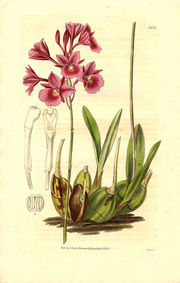Broughtonia
| Broughtonia subsp. var. | ||||||||||||||||||||||||||||||||||||||||||||||||||||||||
|---|---|---|---|---|---|---|---|---|---|---|---|---|---|---|---|---|---|---|---|---|---|---|---|---|---|---|---|---|---|---|---|---|---|---|---|---|---|---|---|---|---|---|---|---|---|---|---|---|---|---|---|---|---|---|---|---|

|
|
| ||||||||||||||||||||||||||||||||||||||||||||||||||||||
| ||||||||||||||||||||||||||||||||||||||||||||||||||||||||
Broughtonia is a genus of orchids (family Orchidaceae) of the Greater Antilles. The genus is abbreviated Bro in trade journals.
With the inclusion of the genera Cattleyopsis Lem. and Laeliopsis Lindl. & Paxton it consists of 6 species.
| Standard Cyclopedia of Horticulture |
|---|
|
Broughtonia (named in honor of an English botanist, Arthur Broughton). Orchidaceae. Epiphytic orchids, requiring stove conditions. Pseudobulbs, 1- or 2-lvd., ovoid or globose: infl. terminal, simple or somewhat branched; sepals and petals similar, somewhat spreading, the latter a little the broader; lip sessile on the base of the column or sometimes a little adnate, lateral lobes inclosing the column, middle lobe spreading; ovary extended into a long cavity; pollina 4, waxy.—A West Indian genus of 2 or 3 species. Sometimes united with Epidendrum.
|
Cultivation
Propagation
Pests and diseases
Species
- Broughtonia cubensis
- Broughtonia domingensis
- Broughtonia lindenii
- Broughtonia negrilensis
- Broughtonia ortgiesiana
- Broughtonia sanguinea
Gallery
-
photo 1
-
photo 2
-
photo 3
References
- Standard Cyclopedia of Horticulture, by L. H. Bailey, MacMillan Co., 1963
External links
- w:Broughtonia. Some of the material on this page may be from Wikipedia, under the Creative Commons license.
- Broughtonia QR Code (Size 50, 100, 200, 500)
